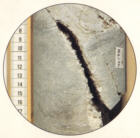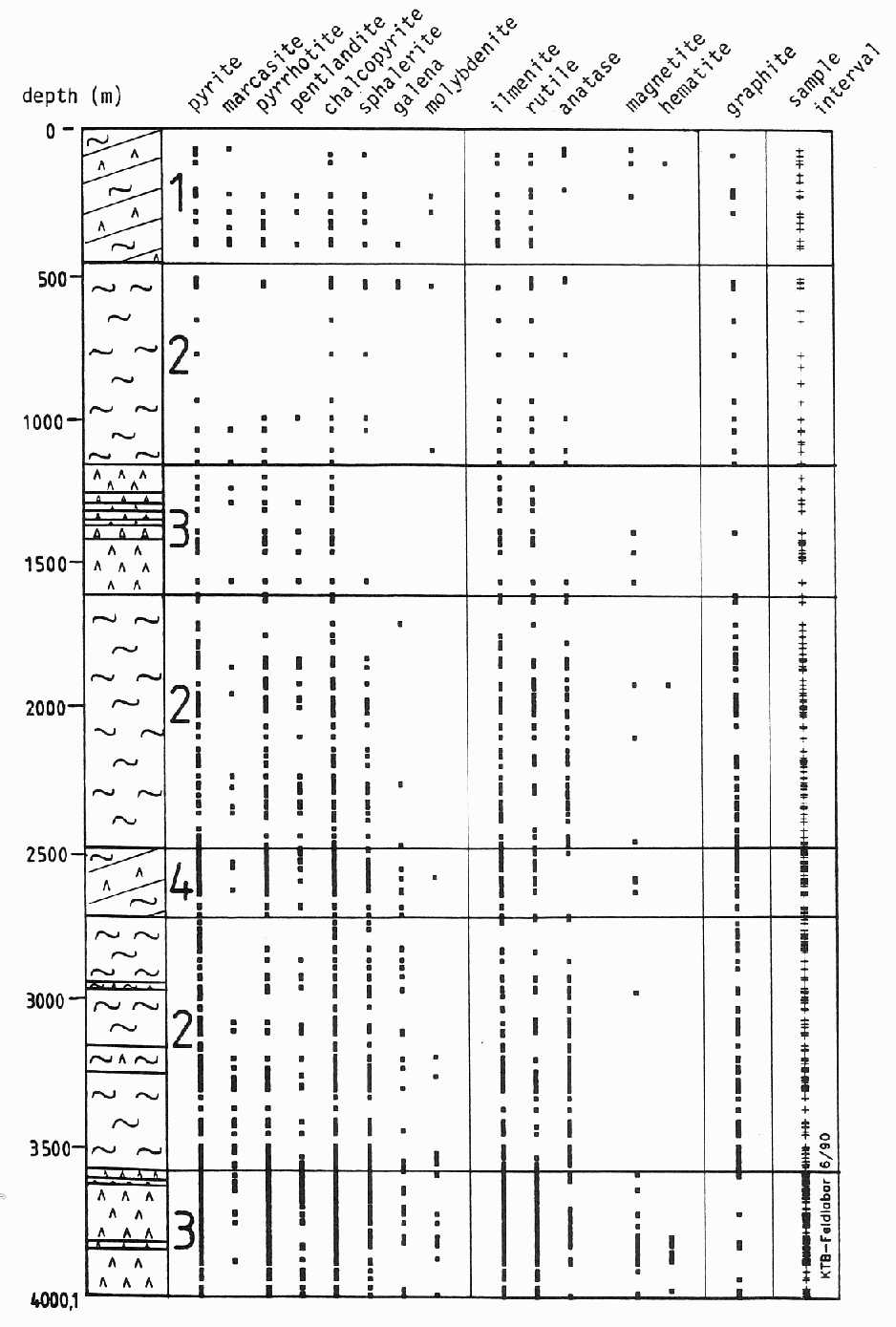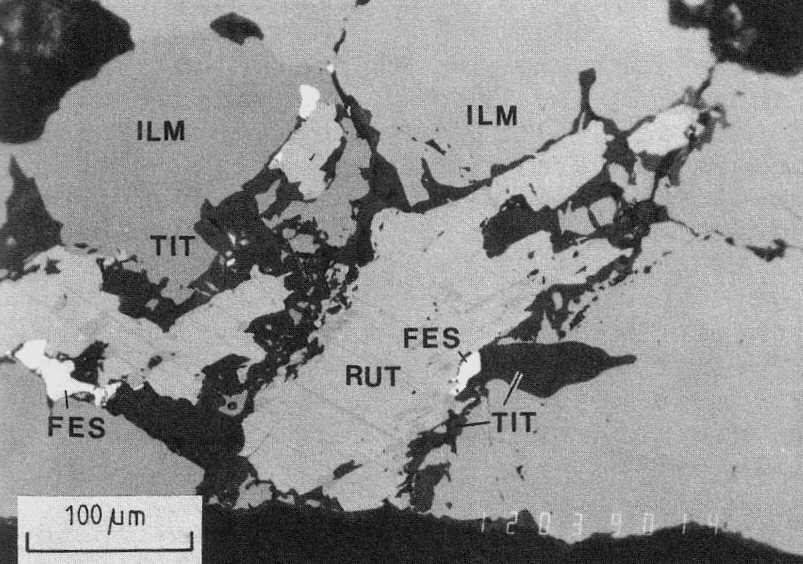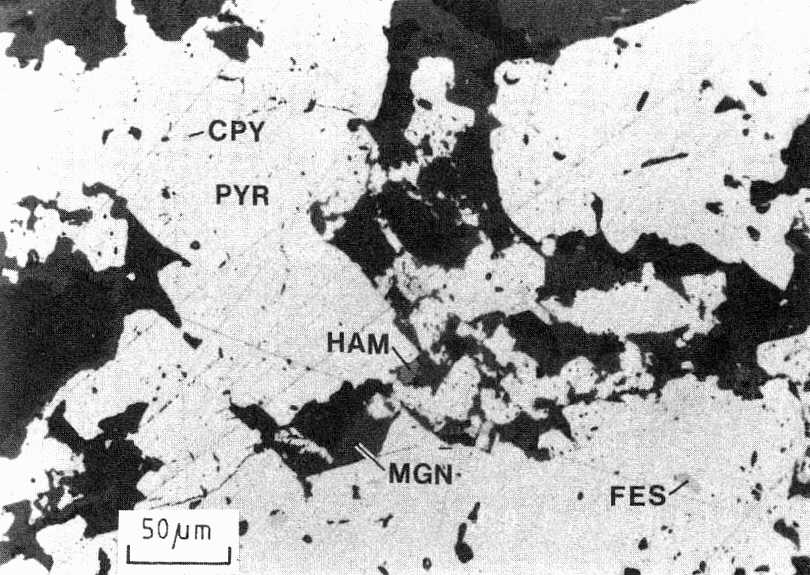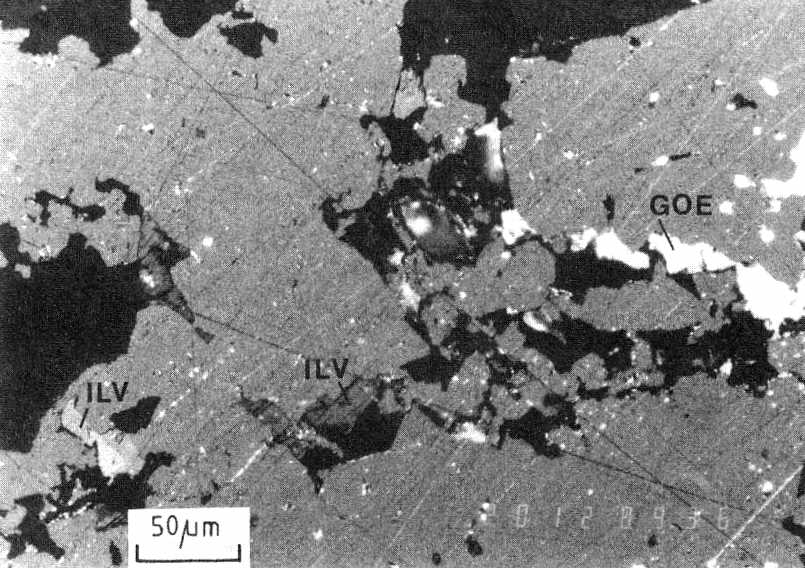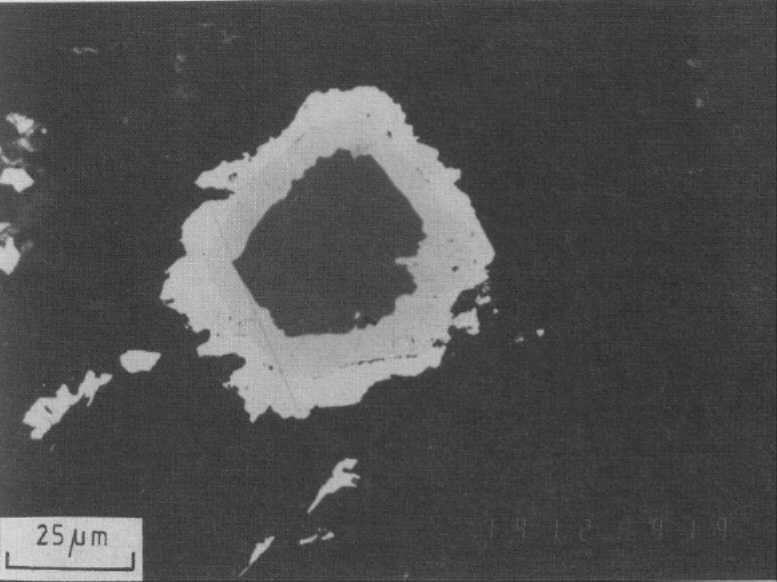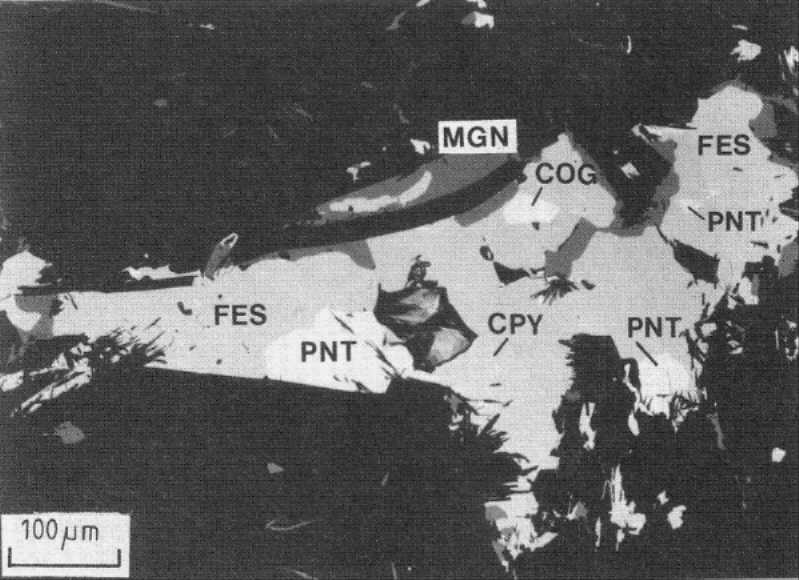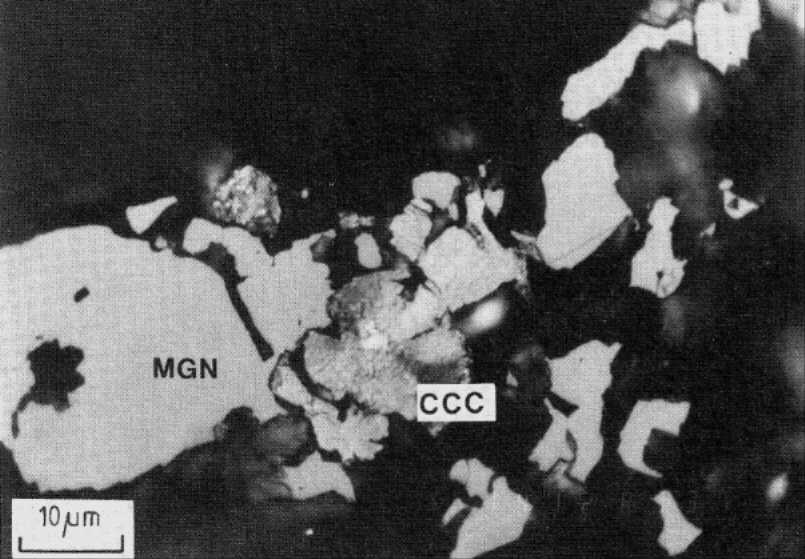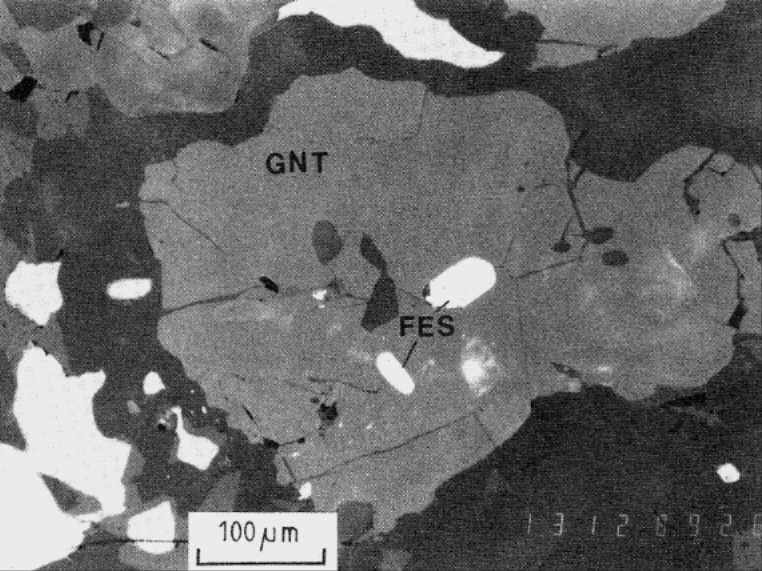B.6 Ore Mineralization
Ore minerals identified within the 4000 m section of the pilot hole are
(1) sulphides (in decreasing order of abundance):
pyrite, pyrrhotite, marcasite, chalcopyrite, sphalerite, galena, pentlandite, molybdenite, millerite, arsenopyrite, Ag-pentlandite, siegenite, cobaltite, gersdorffite, polydymite, violarite, loellingite, and
(2) oxides:
ilmenite, rutile, anatase, leucoxene, titanite, magnetite, hematite, goethite, Cr-spinel (picotite).
In addition variable amounts of graphite and zircon are present, rare ilvaite and traces to tellurobismutite have been identified.
In a few zones of alteration or cataclasis the amount of disseminated pyrite mineralization exceeds 1 %. The down-hole distribution of major sulphides and oxide phases as well as graphite is shown in Table B.6.1.
Tab. B.6.1: Distribution of main opaque minerals within the KTB pilot hole; most of the minerals are ubiquitous; 1 = variegated sequence, 2 = garnet-Al2SiO5-biotite gneiss, 3 = amphibolite-metagabbro sequence, 4 = variegated sequence (similar to 1).
B.6.1 Ore mineralization of gneisses
Pyrite and pyrrhotite are the dominant sulphides of this lithological unit. Within the rock groundmass they occur as disseminated single grains showing a preferred orientation parallel to metamorphic foliation or as small lenses. Both minerals also occur as joint fillings. Along shear zones or in zones of cataclastic deformation, euhedral pyrite is abundant and often associated with graphite. Frequently pyrrhotite in those zones is replaced by marcasite. Supergene alteration causes limonitization of sulfides down to 32 m.
Pyrrhotite of greater depth shows small flamelike exsolution bodies of pentlandite; it is often intergrown with pyrite and marginally replaced by chalcopyrite, locally together with sphalerite (Fig. B.6.1). Pyrrhotite may also form rims around sphalerite. Deformation twinnings are abundant in pyrrhotite close to shear zones.
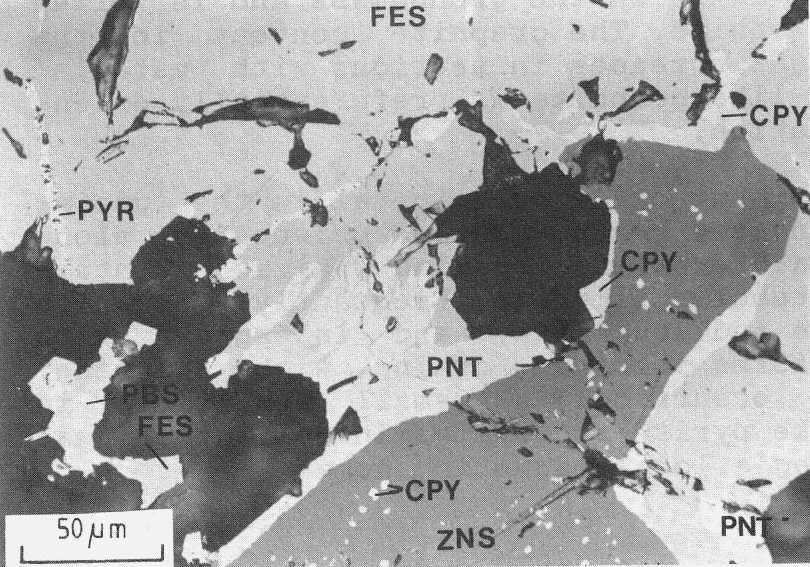
Fig. B.6.1: Complex aggregate of pyrrhotite (FES) with flame-like pentlandite
(PNT) exsolutions: euhedral pyrite (PYR) grains along cracks; replacement
of pyrrhotite by chalcopyrite (CPY) and sphalerite (ZNS) with chalcopyrite
("chalcopyrite disease"?) and galena (PBS) in garnet-sillimanite-biotite
gneiss.
(Polished section 695A8R, 2848.49 m, // nicols).
Chalcopyrite, sphalerite and rare galena form single grains in the rock groundmass; but, like pyrite and pyrrhotite, they may also occur in individual veins (mm to cm width; Fig. B.6.2). Locally arsenopyrite occurs in form of disseminated grains; in a quartz-feldspar dyke it is replaced partially by galena. Argentian pentlandite is intimately intergrown with chalcopyrite, pyrite and pyrrhotite. Here, pyrrhotite contains flame-like exsolutions of pentlandite (Fig. B.6.3).
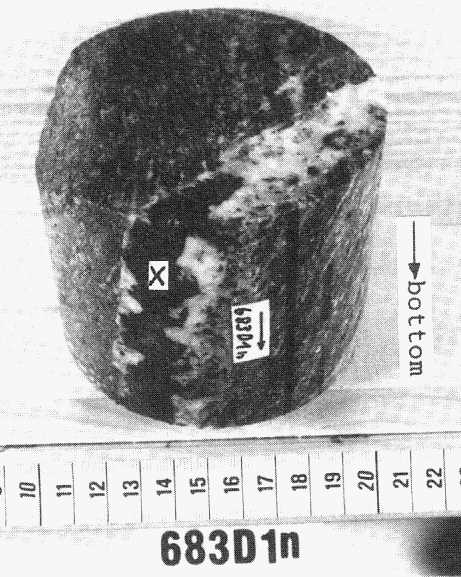
Fig. B.6.2: Vein-like hydrothermal sphalerite mineralization (X) in garnet-bearing
sillimanite-biotite gneiss.
(core piece 683D1n, 2808.09 m, scale in cm).
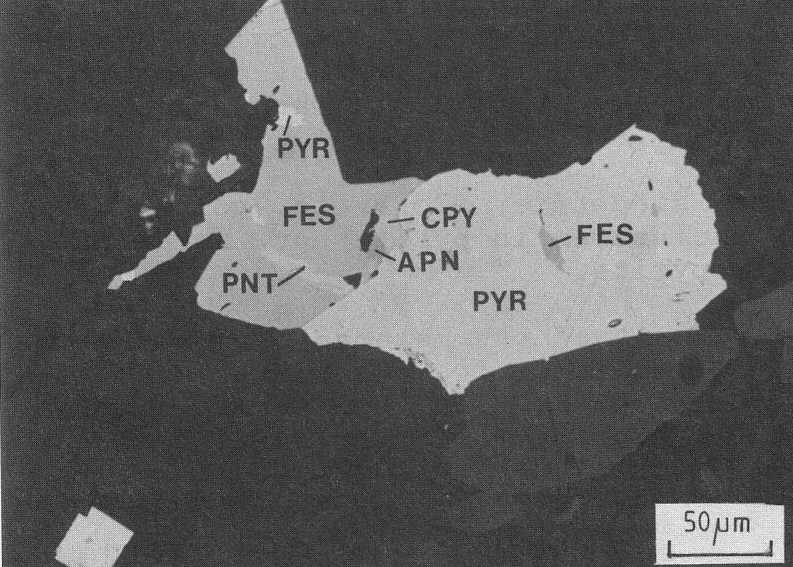
Fig. B.6.3: Pyrite (PYR) and pyrrhotite (FES) with pentlandite (PNT) exsolutions,
intergrown with chalcopyrite (CPY) and Ag-pentlandite (APN) in biotite-hornblende
gneiss.
(Polished section 617B1h, 2533.21 m, // nicols).
Molybdenite forms small laths in the groundmass and is often closely related to graphite. The graphite content in the gneisses is variable and increases in sections with cataclastic deformation; lath-like graphite is preferentially orientated parallel to foliation.
Ilmenite is the predominant oxide ore mineral in the gneiss series. It forms elongated grains often orientated along cleavage planes of mica. Hornblende bearing gneisses contain much larger and more tabular ilmenite. Frequently, ilmenite is altered to anatase and leucoxene, and intergrown with rutile. Rutile also forms isometric grains with twinning. Subordinate magnetite occurs only as small inclusions in pyrite, but a lense-like pyrite-magnetite mineralization was found at 2955 m, causing a local magnetic anomaly.
B.6.2 Ore mineralization of metabasic rocks
Ilmenite is the prevailing ore mineral of the amphibolite-metagabbro sequence. The mineral occurs as tabular or rounded grains, sometimes needle-shaped. It is often replaced by rutile, anatase, leucoxene (Fig. B.6.4) and shows symplectic intergrowth with titanite and hornblende. Below 3575 m, titanite is more frequent, forming rims around ilmenite. Both ilmenite and titanite were found replacing large rutile grains.
Fig. B.6.4: Relic rutile (RUT) with twin lamellae replaced by medium-grey
ilmenite (ILM) and dark-grey titanite; pyrrhotite (FES) along alteration fronts
in garnet-rich amphibolite.
(Polished section 875C21T, 3577.50 m, // nicols, oil).
Magnetite is mostly restricted to the meta-ultamafic bodies; it becomes more abundant within the amphibolite-metagabbro sequence below 3575 m.
Late stage formation of magnetite, hematite, goethite, and ilvaite is documented by replacement of pyrite or accretional intergrowth with pyrite close to open fissures below 3800 m (Fig. B.6.5, B.6.6). The same mineral paragenesis occurs in the form of a small lense within biotite gneiss at 2955.2 m.
Fig. B.6.5: Pyrite (PYR) with inclusions of chalcopyrite (CPY) and pyrrhotite
(FES) replaced by magnetite (MGN) , hematite (HAM), goethite (GOE), and ilvaite
(ILV) in garnet-amphibolite close to open fissure.
(Polished section 928E1nK, 3808.74 m, // nicols, oil).
Fig. B.6.6: Distribution of tabular, homogeneous, dark-grey ilvaite (ILV) and goethite (GOE) with abundant internal reflections (here white); as Fig. B.6.5 but with + nicols.
Major sulphides in metabasic units are pyrite and pyrrhotite with pentlandite exsolutions. Chalcopyrite, locally intergrown with sphalerite, forms rims around pyrrhotite; flame-like marcasite replaces pyrite and pyrrhotite marginally and along subgrain boundaries.
Small amounts of millerite, siegenite, violarite, polydymite, and cobaltite occur as inclusions in pyrite or as minute grains together with chalcopyrite.
Graphite is a minor constituent of the metabasic rocks forming laths-like, curled or spherolitic aggregates in the groundmass. Graphite has been identified in several samples of amphibolite at the gneiss/metabasic transition below 3575 m.
B.6.3 Ore mineralization of meta-ultramafic intercalations
Ilmenite and rutile are the dominant ore minerals of these units. Magnetite is abundant and occurs together with chromian spinel (picotite - Fig. B.6.7). Magnetite may also occur surrounding sulphides or forming single grains within silicates. Similar types of magnetite have been described from serpentinites near Erbendorf and from the Münchberg Massif (Dill 1985 p.131-133; 1988).
Fig. B.6.7: Very dark-grey spinel (picotite) with zoned rim of magnetite;
inner, darker rim consists of chrome-rich magnetite, outer rim is of pure
magnetite; in serpentine-chlorite-hornblende fels.
(Polished section 911F1ahK, 3719.51 m, // nicols, oil).
Pyrite, pyrrhotite with pentlandite and chalcopyrite are thought to derive from primary sulphur abundance within the ultramafic melt. Fe-Ni-Co sulphides such as millerite and cobaltite (Fig. B.6.8) are interpreted to be of secondary hydrothermal origin (Dill 1985).
Fig. B.6.8: Complex sulphide-oxide aggregate: pyrrhotite (FES) with flame-like
pentlandite (PNT), surrounded by magnetite (MGN), chalcopyrite (CPY) inclusions
and cobaltite (COG) accretions; at the far left rim magnetite is bordered
by ilmenite; in serpentine-bearing chlorite-hornblende fels.
(Polished section 300G1j, 1449.30 m, // nicols).
Graphite, as curled or spherolitic aggregates, was found within meta-ultramafic rocks at 1381 m as well as 3719.5 m (Fig. B.6.9). Small single grains or clusters occur within the rock groundmass or close to magnetite and, less frequent, ilmenite.
Fig. B.6.9: Light-grey, homogeneous magnetite (MGN) intergrown with grey,
spherolitic graphite (CCC) in serpentine-chlorite-hornblende fels.
(Polished section 911F1ahK. 3719.51 m, // nicols).
B.6.4 Conclusions
The bulk of ore minerals identified occur in all lithological units: gneisses, amphibolite-metagabbro sequences, and meta-ultramafic bodies. Although oxides are predominant within the metabasites, a relation of mineral parageneses to lithological units can be established in only a few cases.
Microprobe studies of ore mineralization in various lithological units of the pilot hole by Kontny and Friedrich (1989) and Kontny et al. (1990) have led to the distinction of four types of mineralization (Friedrich 1989):
(1) intra-magmatic mineralization with pyrrhotite-pentlandite-chalcopyrite-magnetite as typical for meta-ultramafic units;
(2) mineralization with metamorphic overprint in gneisses (sphalerite-pyrrhotite-pyrite);
(3) mineralizations mobilized by metamorphic processes with pyrrhotite-pyrite-pentlandite-chalcopyrite-sphalerite-Ag-pentlandite associations and veinlike Te-bismutite, Bi bearing galena and pyrrhotite;
(4) post metamorphic mineralization of hydrothermal origin represented by low temperature Fe poor sphalerite, galena, arsenopyrite, pyrite.
Cogenetic inclusions of chalcopyrite and pyrrhotite in pyrite of gneisses and metabasic rocks yield formation temperatures of 334 +/- 17 °C (Yund and Kullerud 1966) and 328 +/- 5 °C (Sugaki et al. 1975).
Occasionally, inclusions of pyrite, pyrrhotite and chalcopyrite, as well as ilmenite and rutile were found in garnet (Fig. B.6.10) and may be interpreted as relics of mineralization related to early, prograde metamorphism.
Fig. B.6.10: Rounded pyrrhotite inclusions (FES) in garnet (GNT); large
grain of pyrrhotite contains inclusions of chalcopyrite; in garnet amphibolite.
(Polished section 916B1f, 3743.14 m, // nicols).
The irregular distribution of pyrrhotite and magnetite may easily be recognized in plots of magnetic susceptibility or natural remanent magnetization (NRM - cf. chap. D: Geophysics). Pyrrhotite within gneisses and metabasic rocks consists of ferrimagnetic and antiferromagnetic types and of combinations of both varieties.
The comparison of type and occurrence of ore mineralization within in the KTB pilot hole and hole SG-3 on the Kola peninsula in the USSR (Genkin et al. 1984) revealed similar mineralization and therefore may indicate similar processes of mineralization in equivalent lithologies of the deeper continental crust (Kontny et al. 1990).
